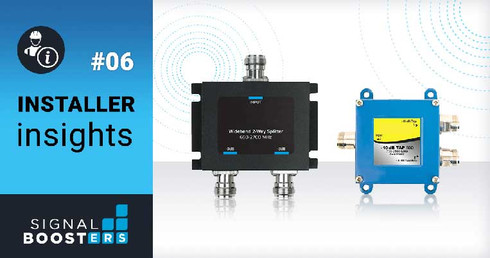Installer Insights 06: Taps vs. Splitters

Installer Insights is a bi-weekly article series provided by industry experts & professionals of residential and commercial cellular DAS and WiFi installations and integrations. This week features the returning Abdul Khan, whose dream of eating a taco while driving the Indy 500 comes closer to reality day-by-day.
How’s it going everyone? This week, we’ll be taking a closer look at two essential accessories which any installer knows like the back of their hand: taps and splitters. However, to those new to the signal boosting industry, the reasons why you might choose to use a tap or a splitter in a specific situation are not always easy to understand. Today, we’ll be answering that question.
Take advantage of our system design and installation services. Learn more or call us for a free consultation: 1-800-969-8189.
What’s a Tap?
A tap (also called a coupler) is an accessory designed for multiple cable runs and antennas. Taps allow for a user to set up two or more indoor antennas while providing a stronger cellular signal to one than the other. This is mostly for a setup which has one inside antenna close to the amplifier and the other being far away. Due to the loss of the signal from the longer table such a run would require, sending a stronger signal through the cable would be the smartest way to go.
There are multiple types of tap, which have different uses. Take for example a 6dB tap and a 10dB tap. A 6dB tap would send a loss of -6dB to the antenna and a loss of 1.5dB to the cable while a 10dB tap would send a loss of -10dB to the antenna and -0.5dB to the cable. For example, feeding a signal of -70dB to a 6dB tap would send a signal of -76dB to the antenna and -71.5dB to the cable, while feeding a signal of -70dB and a 10dB tap would send a signal of -80dB to one end and -70.5dB to the other.

That was really technical, but in simple terms, the difference between to the two taps lies entirely in how much loss you can expect on either end.
What’s a Splitter?
Splitters, too, allow for multiple cable runs and antennas. However, unlike taps, they split signal evenly from their ports, allowing you to accurately measure your dB from the point of exit. They come in two port, three port, and four port variants.
To get technical for a moment: A two-way splitter has a -3 dB loss, a three-way splitter has a -4.8 dB loss and a four-way splitter has a -6dB loss. This means if a -70 dB signal is fed into a two-way splitter, each of the two outputs will receive a roughly -73dB signal (keep in mind, -73 is lower than -70). Similarly a -70 dB signal fed into a three-way splitter will have each of the three outputs receiving a -74.8 dB signal and if it is fed into a four-way splitter, each of the four outputs will receive a -76dB signal.

If that was too much of a mouthful, it’s simple enough to say that a small amount of loss will occur from the splitter, but nothing compared to what will happen trying to broadcast from a single antenna through the air and building materials within your home or office.
When Would You Use a Tap or a Splitter?
A tap is best used in two main scenarios.
First, the goal of any signal booster is to best preserve your boosted signal and distribute it in the most effective way possible. Taps are great for this because they can outperform a splitter in certain situations by keeping the antennas at roughly the same strength. A splitter will have very strong signal at antennas near the amplifier but much weaker signal at antennas far from the amplifier. With a tap, depending on the length of the run, you can have the antennas farther from the amplifier be stronger than those installed via the tap
Second, as previously mentioned, if you’re looking at running a single length of cable over a long space. A splitter will require two or more cable runs, each of which gives a certain amount of loss depending on how far the runs are. This increases cost by multiplying the lengths of total amount of cable to run. A tap needs just one line of cable.
That said, splitters are the best option if you have many individually walled rooms you’re needing to cover. Splitters also are great for evenly distributed antennas across a wide area - for instance, an open sales floor needing multiple antennas would be better served with a splitter than a tap.
Pro Tip: Figure out how many antennas you need for your situation, and buy a splitter for exactly that number: the more ports on your splitter, the more loss each port gives.
Which is Best For Me?
Unfortunately, it’s impossible for me to give a hard and fast answer to that question. In general, however, the more evenly distributed your indoor antenna setup, a splitter is better. If you have long cable runs, taps might be the answer. You can also mix and match to get an ideal setup.
However, your best option is to hire a professional. SignalBoosters.com provides turnkey installation services for small businesses to commercial buildings ranging from 5,000 sq ft to 500,000 sq ft. For a free floor plan analysis (up to 75,000 sq. ft), click here.
Thanks for reading everyone! There’s a lot of complexity to what we do, but splitters and taps are very critical to engineering and integrating great systems for our customers. Hope you’ve enjoyed!
Interested in Learning More? Check Out Our Cellular Info Hub / WiFi Info Hub
Table of Contents

Recent Posts




